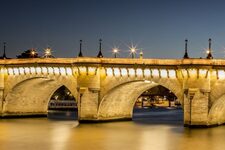Everything you need to know about the Pont Neuf in Paris!
The Pont Neuf, the oldest bridge in Paris, is much more than just a simple structure spanning the Seine. Located between the quays of the Grands Augustins and the Louvre, it connects the right and left banks while passing through the Île de la Cité.
Classified as a Historical Monument and listed as a UNESCO World Heritage Site, the Pont Neuf is now a favored passage point for discovering the historic heart of Paris.
In this article, we reveal everything you need to know about this iconic monument: its history, what you must see on site, recent news, and how to easily get there.

History of the Pont Neuf
Its name is quite misleading, and for good reason: the Pont Neuf is simply the oldest existing bridge in Paris.
Origin and construction
Its construction, initiated during the reign of Henry III in 1578 and completed under Henry IV in 1607, marks a turning point in the history of Parisian urban planning. Unlike other bridges of the time, the Pont Neuf is designed without buildings, an innovation that allows for a clear view of the Seine.
Its structure consists of twelve arches and two distinct parts that frame the Île de la Cité. It also introduces another revolution: wide sidewalks allowing pedestrians to move more easily, a major advancement at a time when the street was often occupied by merchants and horsemen.
A bridge witnessing Parisian history
Since its inauguration, the Pont Neuf has been the scene of many historical events. It is here that one could see the famous "street performers," public entertainers and street vendors, who made the bridge a must-visit center of activity in the city.
Under Louis XIV, the equestrian statue of Henry IV is installed at the center of the bridge, reinforcing its symbolic role in the French monarchy. Destroyed during the Revolution, it was restored during the Restoration, and still stands today as an essential landmark for visitors.
The bridge has also survived the floods of the Seine, the major Haussmannian transformations, and several restorations, notably in the 20th century to strengthen its foundations.
A protected and celebrated heritage
Today, the Pont Neuf is recognized as a jewel of Parisian heritage. It has been classified as a Historical Monument since 1889 and is listed as part of the UNESCO World Heritage alongside the banks of the Seine. Its importance in the urban and architectural history of Paris makes it a central point for history and culture lovers.
Just a short walk from the Pont Neuf, other iconic structures also deserve a visit, such as the Pont des Arts, famous for its love locks and its role as an artistic bridge connecting the Institut de France to the Louvre.
In the next section, we will explore everything to see on and around the Pont Neuf, from its architectural details to its exceptional panoramas.
What to visit on the Pont Neuf?
The Pont Neuf is not just a simple passageway: it offers an immersive experience between history, architecture, and exceptional views of Paris. Here are the must-sees when you cross this iconic monument.
The equestrian statue of Henri IV
Sitting at the center of the bridge, the equestrian statue of Henri IV is one of the strong symbols of Paris. Originally installed in 1618, it was destroyed during the French Revolution and then rebuilt in 1818. This monument recalls the fundamental role of the king in the construction of the bridge and the evolution of the city.
The mascarons of the Pont Neuf
If you look up while crossing, you will notice a series of sculpted mascarons on the arches of the bridge. These 384 grotesque faces, inspired by Italian comedians and mythological figures, were originally conceived by the sculptor Germain Pilon and are now a true architectural curiosity.
A stunning view of Paris
The Pont Neuf is one of the best photo spots in the capital. It offers a panoramic view of the Seine quays, the Louvre, the Conciergerie, and even the Eiffel Tower in the background. At sunset, the place becomes magical, perfect for a romantic stroll or an unforgettable photo session.
For an even more immersive experience, board a bateau-mouche for a cruise on the Seine and admire the Pont Neuf from another angle, gliding peacefully along the water.
Nearby the Pont Neuf: an exceptional heritage
The Pont Neuf is just a few steps away from many other iconic sites in Paris:
- The Tuileries Garden, a green haven nearby, ideal for a bucolic walk. Learn more about the Tuileries Garden.
- The Alexandre III Bridge, one of the most beautiful bridges in Paris, offering a splendid panorama of the Invalides. Learn more about the Alexandre III Bridge.
- The Seine quays, perfect for a walk in Paris on foot or by bike. Discover our recommendations for walks in Paris in our article.
Activities in the Surroundings
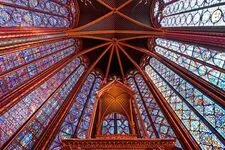
Sainte-Chapelle in Paris
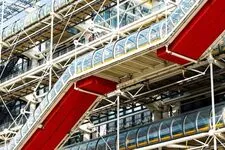
Centre Pompidou - Beaubourg
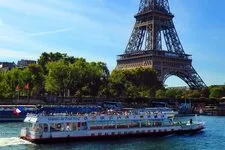
Vedettes du Pont Neuf
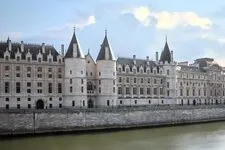
Visit the Conciergerie of Paris
What are the latest news about the Pont Neuf?
The Pont Neuf, although steeped in history, continues to make headlines through significant events and major transformations. Here are the recent updates not to be missed.
Temporary closure on March 18, 2025
The Pont Neuf will be closed to traffic on March 18, 2025, from 1 PM to 4 PM due to a judicial reenactment. This closure also affects part of the Quai des Orfèvres, as well as the section between the Quais des Grands Augustins and the Louvre. Pedestrians will still be able to access the bridge, but motorists will need to plan alternative routes.
Recent works and renovation of the Pont Neuf
Disruptions occurred until December 2024, impacting traffic in the south-north direction of the bridge due to a road subsidence caused by heavy rains. These reinforcement works have restored the foundations and ensured the stability of the bridge for the years to come.
A monumental artistic project in September 2025
The artist JR plans to transform the Pont Neuf into a monumental ephemeral cave in September 2025. This spectacular installation, set to last two weeks, pays tribute to artists Christo and Jeanne-Claude, famous for wrapping the Pont Neuf in 1985.
The work is expected to attract thousands of curious visitors and contemporary art enthusiasts, similar to JR's previous creations, known for their interaction with the urban landscape.
📌 Source: Le Parisien
In the next section, we will explain how to easily access the Pont Neuf, whether you are using public transport, driving, or walking.
How to access the Pont Neuf?
The Pont Neuf being located in the heart of Paris, it is easily accessible by several means of transport. Whether you come by metro, bus, on foot, or by car, here is all the information to get there smoothly.
By public transport
The simplest and fastest way to reach the Pont Neuf is to use the Parisian public transport:
Metro:
- Pont Neuf (line 7) – exit a few meters from the bridge.
- Châtelet (lines 1, 4, 7, 11, 14) – 5 minutes on foot.
- Odéon (lines 4, 10) – ideal for a stroll along the quays before reaching the bridge.
Bus: Several bus lines serve the Pont Neuf directly or indirectly:
- Lines 27, 58, 70, 72 (nearby stops).
- Lines 21, 38, 85 (stops a few minutes on foot).
By car and parking
The Pont Neuf being in a very touristy area, it is recommended to avoid driving due to parking difficulties. However, if you must come by car, here are some options:
- Indigo Saint-Michel Parking (27 Quai des Grands Augustins, 75006 Paris).
- Louvre Samaritaine Parking (1 Place du Louvre, 75001 Paris) – immediately nearby.
💡 Tip: Prefer morning or evening hours to avoid crowds and benefit from smoother traffic.
Access on foot and by bike
For walking or cycling enthusiasts, reaching the Pont Neuf is a pleasure in itself:
Walking tours: the bridge is accessible from the Seine quays, offering a picturesque walk. Discover the best walks in Paris with routes passing by the Pont Neuf (see here).
Vélib’:
- Nearest Vélib’ station: Île de la Cité (1 Place du Pont Neuf).
- Other stations are available near the Louvre and the Saint-Germain-des-Prés district.
